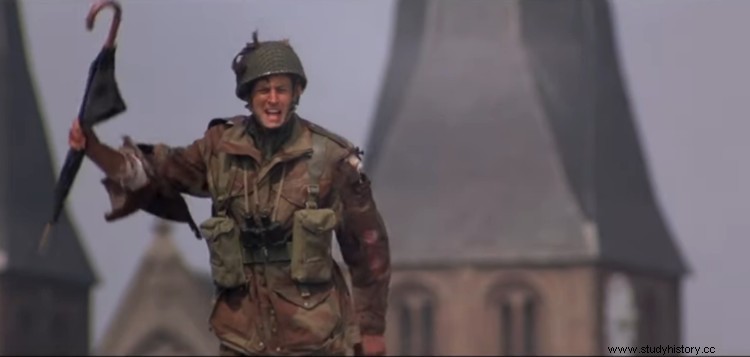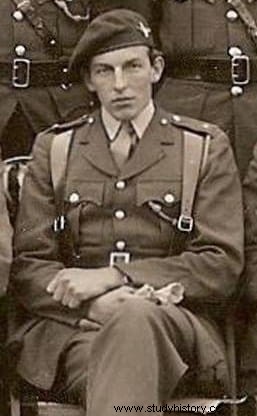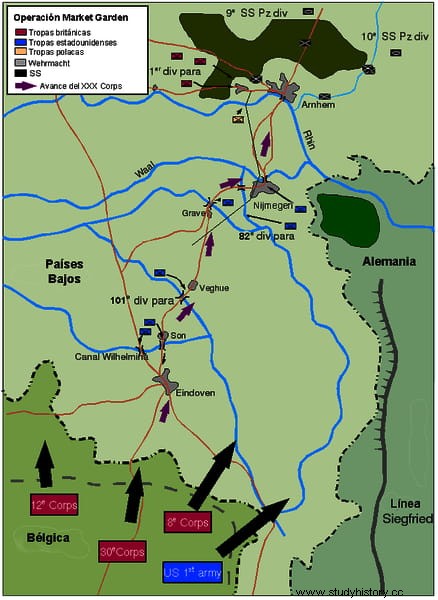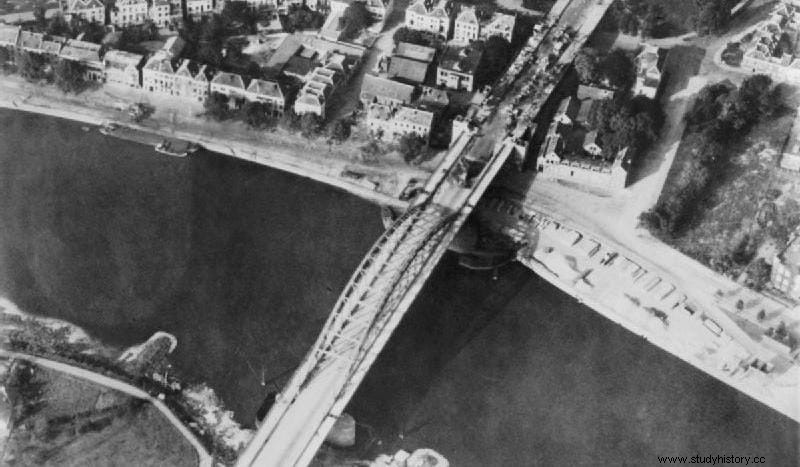Let's go back to World War II. In the heat of the fight against the Germans for the control of a bridge, shots buzzing everywhere, an unheard-of scene takes place when a British commander, wearing a bowler hat, opens an umbrella and with it protects Reverend Egan, chaplain, from enemy fire. military that was trying to reach some wounded. Warned by a colleague that it won't do any good against bullets, he replies with all seriousness: "Oh my God, Pat, but what if it rains?" Although this looks like a sketch of Monty Python, it was a real episode and that eccentric officer was named Allison Digby Tatham-Warter.
It took place in September 1944, during the Battle of Arnhem, fought in the context of Operation Market-Garden, which had been designed by Marshal Montgomery and enthusiastically accepted by Eisenhower, Supreme Allied Commander in Europe. With it, the Allies intended to take the bridges of the Netherlands to ensure the advance of their armored vehicles and create a corridor that would allow them to cross the Rhine River, surrounding the Siegfried Line from the north and thus entering Germany.

An imaginative and daring mission that, however, failed because it was too complex and dependent on details, but thanks to which, exactly three decades later, the journalist and writer Cornelius Ryan published another of his successful books on that war. If in 1956 he had written The longest day , in 1974 -the same year of his death- went on sale A distant bridge , in which he narrated Operation Market-Garden.
The literary reference is not free. The work served as the basis for screenwriter William Goldman to adapt it to the cinema, in which it was one of the best war films:A bridge too far , directed by Richard Attemborough in 1977. And, of course, the anecdote starring Commander Digby was too juicy to pass up, so it is reflected -although more soberly than in reality, perhaps because it seemed too incredible- in the recognition that Major Carlyle's character plays one of the bridges, walking across it with the unheard-of umbrella as if he were in Oxford Street, exposed to being shot.
As we will see, this was not the only anecdote that Digby starred in, a singular type, from the wealthy class, born in Atcham, a town in the county of Shropshire (England) in 1917. He was the son of a landowner who died when he was barely eleven years old , probably dragging the consequences of having been exposed to the chemical gases thrown on the trenches during the First World War; something that perhaps influenced his offspring for the destiny he would choose.

Because in 1935 Digby entered the Royal Military College at Sandhurst, the famous military academy where illustrious names studied, such as the aforementioned Marshal Bernard Montgomery (designer, as we said, of Operation Market-Garden), fellow Marshal Edmund Allenby (who had Lawrence of Arabia under his command), the future premier Winston Churchill, the writer Ian Fleming (creator of James Bond), the actor David Niven, and the future king of Spain Alfonso XII.
After graduating in 1937, the brand new second lieutenant was posted to the Oxfordshire and Buckinghamshire Light Infantry Regiment, which was stationed in India. For a time, Digby led a placid existence dedicated to the hunting hobby characteristic of his landlord origin, carving out a certain prestige in two sports typical of the local nobility but adopted by the British:tiger hunting and pigsticking , as the boar hunt on horseback and with a spear was called (which coincidentally also gave rise to a film in which Richard Attemborough participated, in this case only as an actor:Guilty without a face ).
That indolent stage ended with the outbreak of World War II, but not at the beginning, since Digby did not travel to Europe until he received the news of the death of his brother John in El Alamein, in what was the second family loss because another brother, Kit, had earlier lost his life in the Western Desert Campaign. Faced with that fraternal tragedy, Digby enlisted as a volunteer parachutist in the Second Battalion of the Parachute Regiment, which was in Italy, receiving command of a company.

The training took place in Lincolnshire, close enough to London that he began to forge the legend of him inviting all the officers to a party at the Ritz, where they flew in an American Dakota plane. It is an example of the unique character of that lanky guy (he was slim and was over 1.82 meters tall), independent and rough, who used to get into frequent fights because of his addiction to alcohol -despite the fact that he always appeared in a magazine with impeccable appearance - and was eager to get into combat.
That combination of audacity and impudence not only did not cost him any displeasure but also convinced Lieutenant Colonel John Dutton Frost to put him in charge of Company A, of the Second Battalion, which would lead the assault of seven hundred and forty-five paratroopers of the First Airborne Division British to Arnhem Bridge. The mission was to take the bridge and hold it until Lieutenant General Brian Horrocks' XXX Corps (played by Edward Fox on the big screen) arrived by land, thus combining the two parts of the plan, Market and Garden. Frost, played in the film by Anthony Hopkins, was under the command of Major General Roy Urquhart, played by Sean Connery.
Everything was scheduled to last forty-eight hours, but, as we said, things did not go as planned because Horrocks would take more and more time as they encountered obstacles along the way (a very narrow road surrounded by flooded terrain, no intermediate bridges). captured, lack of air support, unexpected presence of German tanks…). Consequently, XXX Corps could not reach Arnhem and the small contingent of paratroopers defending the bridge had to hold out there, alone, for five desperate days, until their ammunition, food and water were exhausted. During that time, Digby entered the historical anecdote in gold letters.
To begin with, he did not trust radios, so he trained his troops to identify the classic bugle calls with which he intended to send the orders if the technology did not respond and, indeed, a good part of the actions were indicated by that way as communications frequently fail. Also, given his difficulty in memorizing passwords, he decided that it was better for the soldiers to identify him visually and that's when he started carrying umbrellas; something logical because, as he himself said, “just a bloody English fool” he would do something like that. So there was this officer, brandishing the unusual object as he stood before his men, displaying nerves of steel as he remained unmoved by the mortar fire that rained down around him.
With that accessory in one hand and the regulation revolver in the other, he directed a bayonet charge -unsuccessful- over the six hundred meters of the bridge, trying to dislodge the enemy from the other end and, as it must not have seemed like enough of an accessory, he also replaced the burgundy helmet and beret for a bowler hat he found in the rubble, taking his British extravagance to the extreme. Later, the umbrella also served as an improvised weapon to wound the eye, introducing the point through the observation slit to the driver of a German armored car, finishing off that ineffable performance with the anecdote that we explained at the beginning.

If his grotesqueness could still be sublimated, a burst of shrapnel hit him in the butt, leaving him without the back of his pants. Of course, that the funny tree does not prevent seeing the forest:having landed far from the objective, Digby traveled with his paratroopers eight miles in seven hours, killing or capturing a hundred and a half enemies. Later, he knew how to masterfully guide them through the city, because when he found the streets blocked by the Germans, he took a detour to reach the bridge without being located, crossing the gardens that followed one another in the back of the houses. All with a single fatality so far.
Finally the bulk of the Division was evacuated, but recorded three quarters of casualties between dead, wounded and prisoners. Among those who remained captive, not receiving the expected relief, were the surviving defenders of the Arnhem bridge, almost all of them wounded. But Digby should not have resigned himself to putting an end to the legend of him and, admitted to the hospital of Santa Isabel, in Arnhem, he escaped through a window next to his second of him (and he was not the only one; so would General Gerald Lathbury). Both traveled to Mariendaal, guided by a compass made of a button and a needle, being helped by an old farmer. Disguised as painters, they managed to contact the Dutch resistance in Ede.
Incredibly they were successful and the Dutch gave Digby a bicycle with which, under the false identity of Peter Jensen (the deaf-mute son of a lawyer from The Hague), he visited those paratroopers of the Division who had been able to flee and remained hidden. in private homes. Fattening the aforementioned legend, he allowed himself the nerve to help some Wehrmacht officers to push his car to get him out of a ditch where he had fallen and even spent the night in the same house as them without at any time suspecting his identity. of the; paradoxically, a dispute to see who went through a door first, served to completely win his trust.

This was how he managed to gather more than a hundred, whom he intended to lead into action behind German lines in the belief that the Allies would attempt to cross the Rhine shortly. When he learned that this would not be the case, in order not to compromise the population, it was decided to evacuate him in what MI9 (British military intelligence) baptized Operation Pegasus, which had an extension in Belgium with the Comet Line. Digby and his men came out successfully in the first phase, after fording the river making Morse signals with a torch to warn the British of XXX Corps, who controlled the south bank (those of the second were discovered and there were several dead).
So he returned to his country where he was decorated with the Distinguished Service Order (Distinguished Service Order), being himself responsible for endorsing -by writing a report- that one of his lieutenants, John Grayburn, received the Victoria Cross. This officer had fallen in a heroic act, by blocking the way to the Germans on the bridge and personally directing the Royal Engineers to deactivate the explosives with which they intended to dynamite it. In the film he is adapted as the aforementioned Major Carlyle, played by Christopher Good, and his character is syncretized with that of Digby, being him who holds up the umbrella.
After the war, Digby served outside Europe. First, in the newly created British Mandate of Palestine; then the KAR (King’s African Riffles ) operating in Kenya. This protectorate seduced him enough to buy a couple of farms, which he had to defend a few years later, when the Mau Mau Rebellion took place (an anti-colonial uprising of the Kikuyu, Embu and Meru ethnic groups that lasted from 1952 to 1960 ). To do this, Digby organized and financed a force of mounted volunteers with whom he had occasion to go into action again.
The insurrection ended in failure, but Kenya gained its independence soon after, in 1963. By then, the eccentric Briton had definitively abandoned arms, even moderating his hunting hobby (at least hunting big game; he continued with small game), which he replaced with a new concept whose invention he is credited with:organizing photographic safaris. His unspeakable escapades finally ended in 1993, leaving behind three daughters (which he had with his wife, Jane Boyd, the daughter of a wealthy aristocratic settler and whom he married in 1949)…and, surely, an umbrella.
